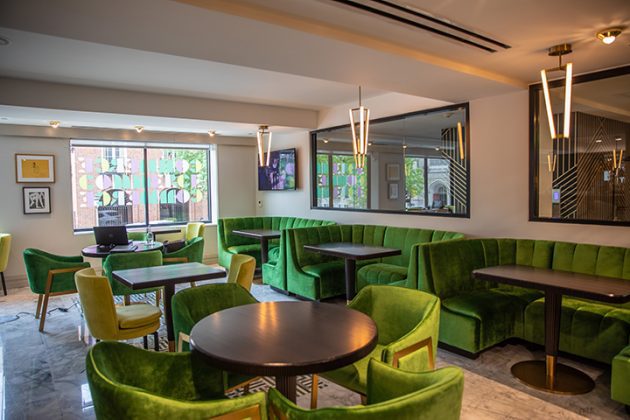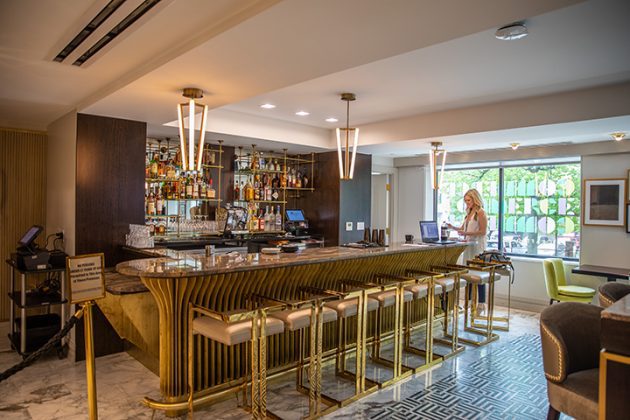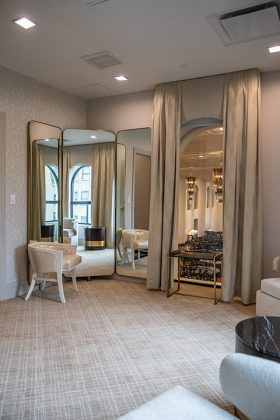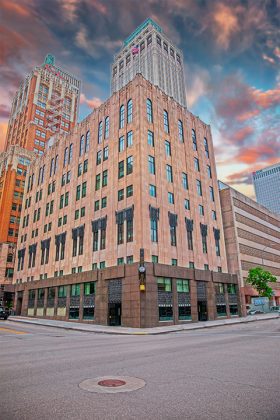For 67 years, the Tulsa Club was a downtown icon of wealth and sophistication.
Beginning in 1927 as an elite gentleman’s club and designed by noted art deco architect Bruce Goff, the elegant building enjoyed an upscale reputation and clientele during Tulsa’s booming oil days. When the Tulsa Club opened with great ceremony, it became a playground for wealthy bankers, civic leaders and oil tycoons.
However, the Tulsa Club’s compelling charm waned and, by 1994, had lost its luster.
“Oil prices tanked and the Tulsa Club closed its doors,” says Kimberly Honea, vice president of sales and marketing for Promise Hotels.
Those intervening years until 2015 were a dismal time for this treasured landmark. The building suffered three fires and frequent vandalism.
The Ross Group bought the building and began a collaboration with Pete and Tina Patel after admiring their vision for an upscale boutique hotel.
Now, the Tulsa Club is a refurbished masterpiece. Credit for this painstaking renovation goes to the Patels, who wanted to make the Tulsa Club a part of their Promise Hotels Collection, which includes 12 other Oklahoma properties.
The stunning restoration began with a historic tax credit and progressed with the combined design vision of The Ross Group, which had worked with the Patels on several of their Curio hotel projects in Oklahoma.
“The inspiration for renovating the Tulsa Club was a combination of many things,” Tina Patel says. “But we wanted to put our mark on the revitalization of downtown Tulsa.”
This collaboration spared nothing to return the Tulsa Club to its glory days. A contemporary style reflects the elegance of the building’s original design.
“We used a combination of new and old world features – historic luxury meets bold modern aesthetics,” Tina says.
Her mission was to maintain as much of the hotel’s 1927 beauty and character as possible. Most of the original marble throughout the building has been preserved. She used a rich dark green as the anchor color with gold accents.
“Green is the new black, and it highlights the bold elegance of the Tulsa Club’s rebirth,” she says.
The hotel has 96 rooms, dressed in soft grays, greens and golds; 16 are upscale suites. The largest has a petite lounge, which once housed a ladies’ sitting room and still has the original mosaic tile fireplace.
The ninth and 10th floors have been transformed into an elegant ballroom that mirrors the 1927 design. The hall accommodates 400 guests for events and overlooks the historic art deco district.
Planned for late summer is a rooftop event terrace with views of east and south Tulsa.
Other features are a gourmet restaurant and a bar, featuring a mix of marble, leather and wood, exuding a rich impression. A coffee bar is reminiscent of the time when the Tulsa Chamber of Commerce was housed here. The elegant entrance is original to Goff’s design.
The Patels want guests, when they walk through that entrance, to feel “overwhelmed with genuine hospitality and top-notch superior service,” Tina says.

The Patels’ Legacy
It seems only natural that Pete and Tina Patel would devote their careers to the hotel and hospitality industry. After all, they both were raised by parents in the field.
Pete grew up in El Reno, where his parents owned a motel. Tina was reared in Sedalia, Missouri, where her parents were also hotel proprietors. Tina attended the University of Missouri-Kansas City and majored in biology with a minor in chemistry.
“I planned to attend med school,” she says. “Instead, I joined the family business.”
Pete got a business and marketing degree from Oklahoma State University and also joined his family’s business.
“The hotel industry is in our blood,” Tina says.
They met and married. Soon after, they built their first hotel, a Best Western in Sand Springs.
“We did everything,” Tina says. “It had 54 rooms with a small staff. We were the desk clerks, did the housekeeping and maintenance, and lived at the hotel. We learned all the ins and outs of hotel management.”
That hotel “boot camp” early in their marriage set up later success; the Patels hold 12 properties in Tulsa, Claremore and Tahlequah. The jewel in the crown is the recently renovated downtown Tulsa Club, which they turned into an upscale boutique hotel.
The Tulsa Club, opened in 1927 as an elite gentleman’s club, closed its doors in 1994. To say the property was in shambles is an understatement.
Yet, this seasoned couple saw beyond the debris and decay and began working with Tulsa’s Ross Group to bring it back to a state of refined elegance. The extensive project took four years of design and construction. They even had the original crystal chandeliers that once graced the ballroom replicated for the project.
“When we stood in that grand ballroom and looked at how beautiful it could be again, we knew we had to do this project.” says Tina, who calls the venture “a rebirth.”
The Tulsa Club was originally designed by the late Bruce Goff, noted for his art deco designs. The Patels worked with the Forrest-Perkins design firm from Dallas to create a distinct atmosphere in the boutique hotel.
“The design firm researched the history of the hotel, working from old photos, and used some modern twists and aesthetics to enhance that old world feeling,” Tina says.
The hotel, opened in April, is the shining star in the Patels’ Promise Hotels portfolio, a part of the Hilton Hotel chain.


































